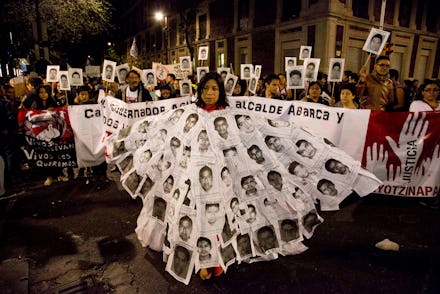Authorities Have Uncovered Yet Another Mass Grave in Mexico

The news: Mexican authorities investigating the disappearance of 43 students who clashed with police last month found yet another mass grave in southern Guerrero state on Tuesday. This marks the second mass grave discovered since early October — and in all likelihood, another call to action for Mexican citizens who are finally taking a stand against government corruption and cartel violence.
The disappearance of the 43 students last month revealed the endemic corruption and collusion between police officers, local officials and alleged members of the drug gangs.
The state governor of Guerrero has resigned and 56 people have been arrested in connection with the crime, according to the BBC, and federal authorities issued arrest warrants for the mayor of the town where the abductions took place, as well as for his wife and the police chief. All are still on the run from authorities.
As more and more clandestine graves are uncovered, protesters and human rights activists are demanding answers. And every morning, newspapers in Mexico City remind the public of the number of days since the 43 students disappeared.
Background: On the night of their disappearance, the students were to peacefully block a highway to solicit commuters for funds that would bring them to Mexico City. The planned event was supposed to commemorate the 1968 massacre of student protesters in the Tlatelolco Plaza by the Partido Revolucionario Institucional government of Gustavo Díaz Ordaz.
While they solicited for funds, the students did not know that the mayor's wife was to give a speech in Iguala that night. The mayor allegedly ordered local police to prevent the students from interrupting the occasion. According to the BBC, eyewitness saw the students forcibly pushed into police cars as the police shot at buses carrying other students, killing three of them and three other bystanders.
Since the discovery of the first mass graves earlier this month, citizens have taken to the streets in protest. College students in Guerrero state burned a portrait of the state's governor, Angel Aguirre, before they set the capitol building on fire. In Mexico City, thousands of students protested in front of the attorney general's office. The attorney general is leading the investigation of the case.
Protesters also demanded the resignation of President Enrique Peña Nieto earlier this month as family members of the missing students continue to hold vigils across the capital.
Why it matters: It's easy to get lost in such dizzying and dehumanizing numbers: 43 students, 26,000 missing since 2006, a drug war that has claimed 70,000 lives. But the disappearance of the 43 has provided a glimpse into much of daily life in parts of Mexico where public officials are so deeply entwined with criminal activity.
In a recent opinion piece, Alejandro Paéz Varela, the founding director of SinEmbargo.com, wrote of the dissonance, "Marches, protests, rage. International condemnation. The country which, according to the cover of Time magazine, was being 'saved' by Enrique Peña Nieto and his reforms is now, on second look, seen as one of savage and corrupt officials."
As Francisco Goldman pointed out in the New Yorker this week, an important question is making the rounds in Mexico City: "Is the government withholding what it knows about the missing students' whereabouts for political reasons?"
The disappeared 43 are part of a larger systemic issue, evidence of the routine failure of authorities to investigate, locate the victims and prosecute the perpetrators. The search continues.